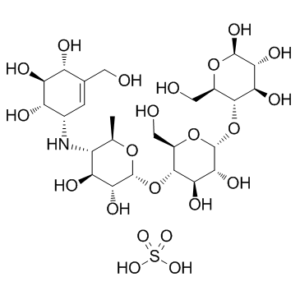This product is for research use only, not for human use. We do not sell to patients.

| Size | Price | Stock |
|---|---|---|
| 5g | $300 | To Be Confirmed |
| 10g | $500 | To Be Confirmed |
| 20g | $750 | To Be Confirmed |
Cat #: V4337 CAS #: 1221158-13-9 Purity ≥ 98%
Description: Acarbose sulfate (also known as BAY g 5421 sulfate; trade names: Glucobay; Prandase; Precose) is an anti-diabetic drug used to treat diabetes mellitus type 2 and, in some countries, prediabetes by combining with a proper diet and exercise program to control high blood sugar in people with type 2 diabetes.
Publications Citing InvivoChem Products
Product Promise

- Physicochemical and Storage Information
- Protocol
- Related Biological Data
- Stock Solution Preparation
- Quality Control Documentation
| Molecular Weight (MW) | 743.68 |
|---|---|
| Molecular Formula | C25H45NO22S |
| CAS No. | 1221158-13-9 |
| Storage | -20℃ for 3 years in powder formr |
| -80℃ for 2 years in solvent | |
| SMILES Code | O[C@@H]1C(CO)=C[C@H](N[C@H]2[C@H](O)[C@@H](O)[C@@H](O[C@@H]3[C@@H](CO)O[C@H](O[C@@H]4[C@@H](CO)O[C@@H](O)[C@H](O)[C@H]4O)[C@H](O)[C@H]3O)O[C@@H]2C)[C@H](O)[C@H]1O.O=S(O)(O)=O |
| Synonyms | BAY-g-5421 sulfate; BAY-g 5421; BAY g-5421 sulfate; Acarbose sulfate; Glucobay; Prandase; Precose |
| Protocol | In Vitro | Acarbose (1, 2, and 3 μM) dose- and time-dependently inhibits TNF-α-induced VSMC proliferation and migration. Acarbose (1, 2, and 3 μM) dose-dependently decreases β-galactosidase, Ras expression and increased p-AMPK expression in TNF-α pre-treated A7r5 cells. |
|---|---|---|
| In Vivo | Acarbose (300 mg/60 kg body weight) decreases the fasting blood glucose, and regulates the glucose tolerance of DM rats without body weight loss. Acarbose significantly suppresses serum IL6 and TNF-α in DM rats. |
| Solvent volume to be added | Mass (the weight of a compound) | |||
|---|---|---|---|---|
| Mother liquor concentration | 1mg | 5mg | 10mg | 20mg |
| 1mM | 1.3447 mL | 6.7233 mL | 13.4466 mL | 26.8933 mL |
| 5mM | 0.2689 mL | 1.3447 mL | 2.6893 mL | 5.3787 mL |
| 10mM | 0.1345 mL | 0.6723 mL | 1.3447 mL | 2.6893 mL |
| 20mM | 0.0672 mL | 0.3362 mL | 0.6723 mL | 1.3447 mL |
| Quality Control Documentation |
|
|---|
This equation is commonly abbreviated as: C1 V1 = C2 V2
- (1) Please be sure that the solution is clear before the addition of next solvent. Dissolution methods like vortex, ultrasound or warming and heat may be used to aid dissolving.
- (2) Be sure to add the solvent(s) in order.




































